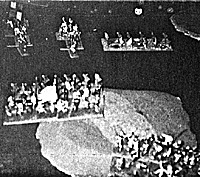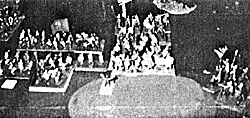 The armies of Antiochus III and Achaeus make interesting wargaming forces. Following are some guidelines for recreating these forces:
The armies of Antiochus III and Achaeus make interesting wargaming forces. Following are some guidelines for recreating these forces:
Historical Enemies - Achaeus: His reign saw conflict with Attalus of Pergamum [Pergamene - Book Two], the Pisidian hill tribes and with the King's forces [Seleucid - Book Two].
Historical Enemies - Antiochus III: This period of the reign of Antiochus III saw a serious civil war with Achaeus [Seleucid - Book Two], and conflict was also possible throughout the period with Ptolemy IV [Ptolemaic - Book Two].
During his eastern expedition, Antiochus III clashed with the army of Xerxes [Early Armenian - Book Two], that of the Parthians [Parthian -Book Two], the Bactrians [Bactrian Greek - Book Two], an Indian kingdom [Mountain or Classical Indian - Book Two] and finally several Arab tribes [later pre-Islamic Arab - Book Two].
In addition, confrontations were possible for Antiochus III throughout this period with Kappadokia [Ariarathrid Kappadokian - Book Two], and the Skythians [Skythian - Book One].
Potential sub-generals: Achaeus' main general was Garsyeris. Antiochus III retained a cadre of skilled sub generals including Theodotus " One and a half", Theodotus the Aetolian, Zeuxis and Hermogenes, and also Diognetus his admiral. During his eastern expedition his generals included Polyxenidas the Rhodian, Diogenes the satrap of Media, Nicomedes of Cos and Nicolaus the Aetolian.
Potential Allies: Antiochus III cooperated (allied is probably too strong a phrase) with Attalus of Pergamum [Pergamene]. Achaeus, though he received little actual support, was allied with Ptolemaic Egypt, and could have received more substantial support. Although he signed "alliances" with each foe conquered during the eastern expedition, all were based on subjugation and none resulted in troops cooperating.
Variations by Troop Type:
-
Companions, Agema and Argyraspids -- none of these elite units were available to Achaeus, as all would be drawn from areas controlled by Antiochus III.
Phalanx - Throughout most of this period, the military settlements in Asia Minor and those in Syria and the east were never in the same hands, so therefore each leader would have been limited in the number of regular core troops that could be fielded. Antiochus lacked the resources of Asia Minor before the reckoning with Achaeus, as he had in his previous confrontation with Ptolemy IV. He presumably scraped together as large a force as he could muster, therefore 12-16 elements of phalanx seem appropriate when opposing Achaeus. Achaeus should probably field 8-12 elements - he was strong enough to force Attalus all the way back to the gates of Pergamum when using all of the forces available to him, and Asia Minor accounted for a fairly high proportion of the military colonists from whom the phalanx was drawn.
Levies - As anarchy bread by civil war engulfed the kingdom, leaders had to increase the proportion of levied troops in their forces. Both Antiochus and Achaeus should employ 4-12 levies [Irr Hd(O)] against one another.
Scythed Chariots - Antiochus III was the first Seleucid ruler since the reign of Seleucus I we know to have employed scythed chariots, and he was fond of them as a weapon. They should be allowed by his forces throughout his reign. There is no mention of their use by Achaeus.
Civic militia cavalry or Tarantines - Achaeus only had access to the main area of Asia Minor, during this period. Antiochus III had a strong grip on the resources of the remainder of the empire. Therefore only up to 2 civic militia cavalry may be used by Achaeus, and up to 4 civic militia cavalry are available to Antiochus III. Up to 6 mercenary Tarantines are available to all.
Elephants - Antiochus III was a strong believer in the role of elephants in warfare, and used them frequently throughout his reign. During this period he should be allowed 0-3.
Theurophoroi - had completely replaced peltasts by this stage - they should be fielded as Reg Ax(S).
PISIDIAN ARMY LIST:
 Since there is no official list covering the armies of the Pisidian hill tribes during this era, I present the following guidelines, which can be used to recreate these armies on the table, as a potential opponent for the army of Achaeus or that of Antiochus III.
Since there is no official list covering the armies of the Pisidian hill tribes during this era, I present the following guidelines, which can be used to recreate these armies on the table, as a potential opponent for the army of Achaeus or that of Antiochus III.
PISIDIAN HILL TRIBES 300BC-100BC
Warm. Ag 1. WW, H(S), Wd, Rgo, Rd, BUA.
C-in-C - Irr Cv(O) @ 17AP
1 Sub-General - as above 1-2
Cavalry - Irr Cv(O) @ 7AP 0-4
Cavalry - Irr LH(O) @ 5AP 1-4
Warriors - Irr Ax(O) @ 3AP 35-150
Archers - Irr Ps(O) @ 2AP 6-12
Peasants - Irr Ps(I) @ 1AP 0-24
Upgrade peasants to Irr Ps(S) @ 3AP 0-1/2
Pirate lembi - Irr Bts(O) @ 2AP 0-3
Pirates - Irr Ax(I) @ 2AP 1 per Bts(O)
Greek City allies - List: Hellenistic Greek (Bk2) 0-16
FURTHER READING:
If any of this catches your fancy, a list of suggested general works which provide a much more detailed look at this fascinating period was included with chapter one of this series.
Back to Saga #62 Table of Contents
Back to Saga List of Issues
Back to MagWeb Magazine List
© Copyright 1998 by Terry Gore
This article appears in MagWeb (Magazine Web) on the Internet World Wide Web. Other military history articles and gaming articles are available at http://www.magweb.com